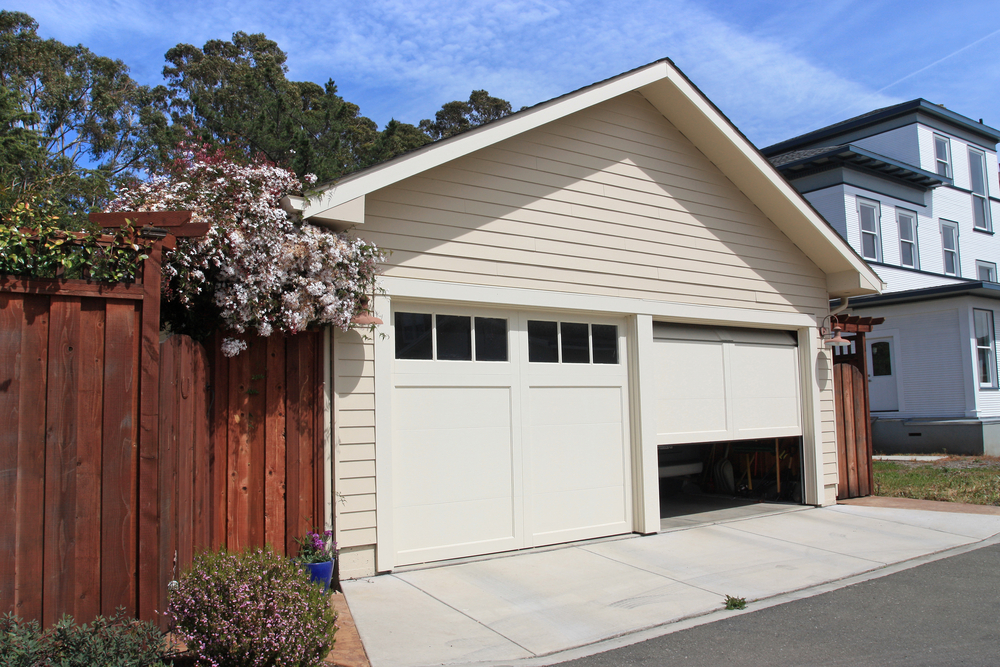In most situations garage doors can be safely power washed to remove dirt and grime, leaving a sparkling end result.
However there are a few important considerations before you start on the process.
Considerations Before You Power Wash Your Garage Door
Contents

Before you go and retrieve your jet wash from the garage there are a few elements you should consider. This should help to avoid unnecessary issues down the road.
Garage Door Material
Generally speaking metal or composite garage doors can be safely power washed. However if you’ve opted for a beautiful timber garage door – such as those that swing open with hinges at the sides – then power washing may not be a good idea. The force from a power washer can damage the beautiful surface, causing additional hassle and expense.
Condition of Your Garage Door
A garage door that has seen better days may come off badly from being power washed. For example if your garage door has loose or flaking paint, then the power of a jet wash is likely to make this considerably worse. Not only will your garage door not thank you, but you’ll also have to go to the trouble of brushing up all the paint flakes thereafter.
In contrast, a garage door that has been suitably looked after and has a surface that is in a decent condition should make a good candidate for power washing.
Weather Conditions
Power washing is a job best done in good weather conditions. There are a number of reasons for this. Firstly, on a dry, still, sunny day your garage door will dry quickly and efficiently. This will reduce the chance of the water leading to rust.
Just as importantly, rainy weather can splash up dirt and grime from your driveway, quickly returning your garage door to how it looked before washing.
For the above reasons, the best option is to power wash your garage door on a dry morning, where there is plenty of time for the door to air-dry naturally.
Is Power Washing Really Necessary?
One final consideration before we move on to how to power wash your garage door, is whether it’s really even necessary in the first place.
Certainly, power washing is fun for many people, so there’s that consideration. But it can also be a pain to get the equipment out, fill it up, use it, and then clean everything down afterwards.
In many cases a bucket of soapy water and a sponge can be just as effective, especially if the issue is loose dust and dirt rather than baked-on stains.
Assuming you’ve committed to power washing (and why now?!) here are some handy tips to make things go smoothly…
How to Power Wash Your Garage Door
Let’s be honest: power washing can be fun. But if you want the very best results possible from your efforts, there are a few aspects worthy of consideration…
Consider the Contents of Your Garage
Not all garage doors are 100% water-tight. Quite the opposite: many are designed with small gaps around to permit ventilation in the winter months. But this means there is a risk of some spray making it into your garage even with the door firmly shut.
Consider whatever you’re storing immediately behind the garage door, and whether it would cope getting a bit damp. Cardboard boxes and such might be safer moved away during the cleaning process.
Protect Yourself Before Starting
Consider protection equipment, especially in warmer weather where shorts and t-shirts may be the order of the day. At least consider wearing some gloves to protect your hands. You’re also likely to get quite wet when power washing your garage door, as spray-back is almost inevitable. So don’t wear your finest designer outfit on the day!
Start By Soaking The Door
Just like soaking the dishes, initially wetting your garage door can start the process of lifting stubborn marks and stains.
Whether you opt to use a low on low power, or grab a bucket, an initial soak can make the whole process easier. In the same way, adding some detergent to the water will also help.
In warm weather be sure to start the power washing soon afterwards, otherwise the door may dry out quickly after soaking.
Consider a Gentle Scrub Afterwards
While it’s unnecessary in many cases, some homeowners like to quickly run over the garage door with a sponge, to further loosen any dirt and debris ready for the “main event”. This can speed up the power washing process in some cases, particularly when a garage door is particularly heavily-soiled.
Work in the Right Direction
Now it’s time to power up the jet wash! The key is being methodical, and working from the top down. In this way, the dirty water runs down over the areas you haven’t yet cleaned.
As many garage doors have horizontal lines, ribbing or patterning across them, it can be wise to start at the top, working left to right. Once that top part is done, move your attention down a little and do another horizontal pass. With each sweep you move further and further down the door until you reach the bottom.
All the time, the area above should remain cleaner than it otherwise would have done. At the same time, on heavily-soiled doors some spray-back is inevitable.
Rinse the Garage Door
Power washing is fantastic for blasting off dirt and grime, but the process can splash the dirt onto other parts of the door.
Be honest with yourself after the power washing process and consider whether a final rinse is warranted. Often going over it one last time with a garden hose can make the difference between an “ok” job and a great one.
Clean the Driveway
Rain has a nasty habit of kicking up dirt from your driveway, and essentially sticking it back onto your garage door. This can make the impact of your cleaning depressingly short-lived.
If you want to do a really thorough job then after cleaning your garage door, also clean your driveway. Power wash the dirt away, use a broom or a garden vacuum. Remember: a cleaner drive will mean a cleaner garage door.
Considerations for Drying
If the weather is good then drying your garage door might be a moot point. Just leave it in the sun to dry naturally.
However, depending on the material your garage door is made from, or the weather conditions on the day, you may want to consider partially or fully drying your garage door after treatment.
A squeegee can be handy for this. Even better, my tool of choice is a window vacuum like Karcher. It’s quick, easy, and means no streaking at all. I believe the end result makes the small additional effort worthwhile.
